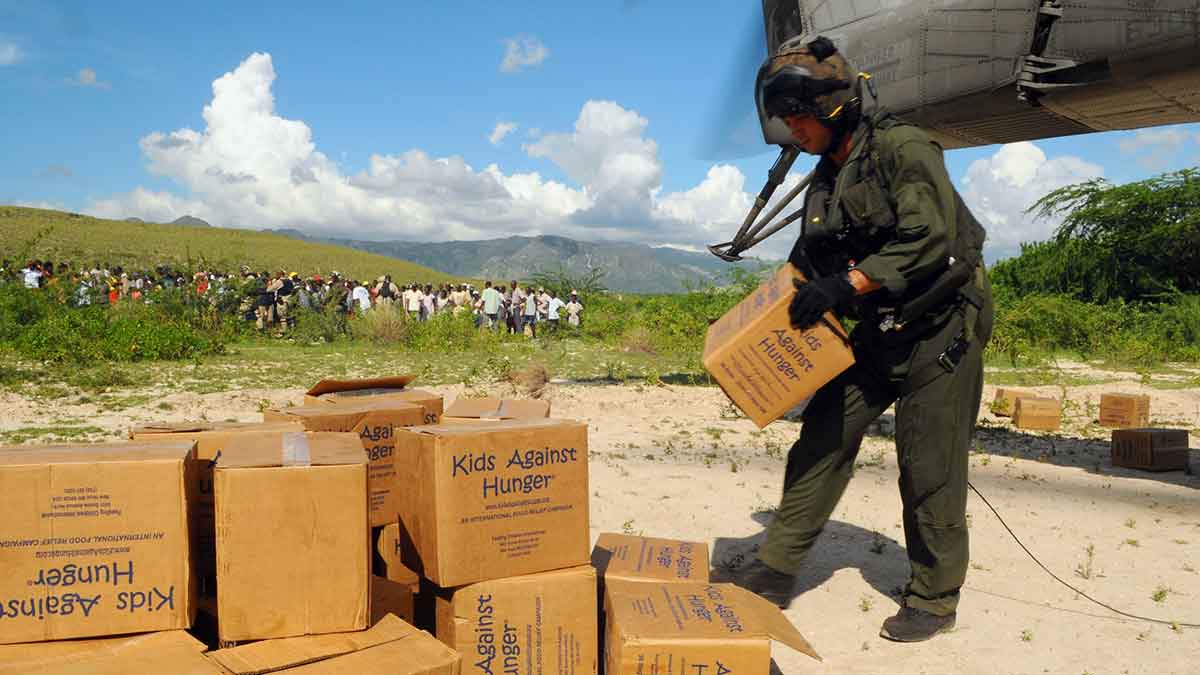This article was recommended to us by a Haitian friend of the WSP. We reprint it for the information contained – the on the ground conditions as our contact in haiti confirms them. It doesn’t reflect the WSP policies.
••••••
America’s Role in Haiti’s Hunger Riots
By Bill Quigley
Monday 21 April 2008
Riots in Haiti over explosive rises in food costs have claimed the lives of six people. There have also been food riots worldwide in Burkina Faso, Cameroon, Cote d’Ivorie, Egypt, Guinea, Mauritania, Mexico, Morocco, Senegal, Uzbekistan and Yemen.
The Economist, which calls the current crisis the silent tsunami, reports that last year wheat prices rose 77 percent and rice 16 percent, but since January rice prices have risen 141 percent. The reasons include rising fuel costs, weather problems, increased demand in China and India, and the push to create biofuels from cereal crops.
Hermite Joseph, a mother working in the markets of Port-au-Prince, told journalist Nick Whalen that her two kids are “like toothpicks – they’re not getting enough nourishment. Before, if you had $1.25, you could buy vegetables, some rice, 10 cents of charcoal and a little cooking oil. Right now, a little can of rice alone costs 65 cents, and is not good rice at all. Oil is 25 cents. Charcoal is 25 cents. With $1.25, you can’t even make a plate of rice for one child.”
The St. Claire’s Church Food program, in the Tiplas Kazo neighborhood of Port-au-Prince, serves 1,000 free meals a day, almost all to hungry children – five times a week in partnership with the What If Foundation. Children from Cit-Soleil have been known to walk the five miles to the church for a meal. The costs of rice, beans, vegetables, a little meat, spices, cooking oil and propane for the stoves, have gone up dramatically. Because of the rise in the cost of food, the portions are now smaller. But hunger is on the rise, and more and more children come for the free meal. Hungry adults used to be allowed to eat the leftovers once all the children were fed, but now there are few leftovers.
The New York Times lectured Haiti on April 18 that “Haiti, its agriculture industry in shambles, needs to better feed itself.” Unfortunately, the article did not talk at all about one of the main causes of the shortages – the fact that the US and other international financial bodies destroyed Haitian rice farmers to create a major market for heavily subsidized rice from US farmers. This is not the only cause of hunger in Haiti and other poor countries, but it is a major force.
Thirty years ago, Haiti raised nearly all the rice it needed. What happened?
In 1986, after the expulsion of Haitian dictator Jean Claude “Baby Doc” Duvalier, the International Monetary Fund (IMF) loaned Haiti $24.6 million in desperately needed funds (Baby Doc had raided the treasury on the way out). But, in order to get the IMF loan, Haiti was required to reduce tariff protections for Haitian rice and other agricultural products and some industries, to open up the country’s markets to competition from outside countries. The US has by far the largest voice in decisions of the IMF.
Doctor Paul Farmer was in Haiti then and saw what happened. “Within less than two years, it became impossible for Haitian farmers to compete with what they called ‘Miami rice.’ The whole local rice market in Haiti fell apart as cheap, US subsidized rice, some of it in the form of ‘food aid,’ flooded the market. There was violence … ‘rice wars,’ and lives were lost.”
“American rice invaded the country,” recalled Charles Suffrard, a leading rice grower in Haiti in an interview with the Washington Post in 2000. By 1987 and 1988, there was so much rice coming into the country that many stopped working the land.
The Rev. Gerard Jean-Juste, a Haitian priest who has been the pastor at St. Claire and an outspoken human rights advocate, agrees. “In the 1980s, imported rice poured into Haiti, below the cost of what our farmers could produce it. Farmers lost their businesses. People from the countryside started losing their jobs and moving to the cities. After a few years of cheap imported rice, local production went way down.”
Still, the international business community was not satisfied. In 1994, as a condition for US assistance in returning to Haiti to resume his elected presidency, Jean-Bertrand Aristide was forced by the US, the IMF and the World Bank to open up the markets in Haiti even more.
But Haiti is the poorest country in the Western Hemisphere; what reason could the US have for destroying the rice market of this tiny country?
Haiti is definitely poor. The US Agency for International Development reports the annual per capita income is less than $400. The United Nations reports life expectancy in Haiti is 59, while in the US it is 78. Over 78 percent of Haitians live on less than $2 a day, more than half live on less than $1 a day.
Yet, Haiti has become one of the top importers of rice from the United States. The US Department of Agriculture 2008 numbers show Haiti is the third-largest importer of US rice – at over 240,000 metric tons of rice. (One metric ton is 2,200 pounds).
Rice is a heavily subsidized business in the US. Rice subsidies in the US totaled $11 billion from 1995 to 2006. One producer alone, Riceland Foods of Stuttgart, Arkansas, received over $500 million in rice subsidies between 1995 and 2006.
The Cato Institute recently reported that rice is one of the most heavily supported commodities in the US – with three different subsidies together averaging over $1 billion a year since 1998 and projected to average over $700 million a year through 2015. The result? “Tens of millions of rice farmers in poor countries find it hard to lift their families out of poverty because of the lower, more volatile prices caused by the interventionist policies of other countries.”
In addition to three different subsidies for rice farmers in the US, there are also direct tariff barriers of three to 24 percent, reports Daniel Griswold of the Cato Institute – the exact same type of protections, though much higher, that the US and the IMF required Haiti to eliminate in the 1980s and 1990s.
US protection for rice farmers goes even further. A 2006 story in The Washington Post found that the federal government has paid at least $1.3 billion in subsidies for rice and other crops since 2000 to individuals who do no farming at all; including $490,000 to a Houston surgeon who owned land near Houston that once grew rice.
And it is not only the Haitian rice farmers who have been hurt.
Paul Farmer saw it happen to the sugar growers as well. “Haiti, once the world’s largest exporter of sugar and other tropical produce to Europe, began importing even sugar – from US-controlled sugar production in the Dominican Republic and Florida. It was terrible to see Haitian farmers put out of work. All this speeded up the downward spiral that led to this month’s food riots.”
After the riots and protests, President Rene Preval of Haiti agreed to reduce the price of rice, which was selling for $51 for a 110-pound bag, to $43 dollars for the next month. No one thinks a one-month fix will do anything but delay the severe hunger pains a few weeks.
Haiti is far from alone in this crisis. The Economist reports a billion people worldwide live on $1 a day. The US-backed Voice of America reports about 850 million people were suffering from hunger worldwide before the latest round of price increases.
Thirty-three countries are at risk of social upheaval because of rising food prices, World Bank President Robert Zoellick told The Wall Street Journal. When countries have many people who spend half to three-quarters of their daily income on food, “there is no margin of survival.”
In the US, people are feeling the worldwide problems at the gas pump and in the grocery. Middle-class people may cut back on extra trips or on high price cuts of meat. The number of people on food stamps in the US is at an all-time high. But in poor countries, where malnutrition and hunger were widespread before the rise in prices, there is nothing to cut back on except eating. That leads to hunger riots.
In the short term, the world community is sending bags of rice to Haiti. Venezuela sent 350 tons of food. The US just pledged $200 million extra for worldwide hunger relief. The UN is committed to distributing more food.
What can be done in the medium term? The US provides much of the world’s food aid, but does it in such a way that only half of the dollars spent actually reach hungry people. US law requires that food aid be purchased from US farmers, processed and bagged in the US and shipped on US vessels – which cost 50 percent of the money allocated. A simple change in US law to allow some local purchase of commodities would feed many more people and support local farm markets.
In the long run, what is to be done? The president of Brazil, Luiz Inacio Lula da Silva, who visited Haiti last week, said “Rich countries need to reduce farm subsidies and trade barriers to allow poor countries to generate income with food exports. Either the world solves the unfair trade system, or every time there’s unrest like in Haiti, we adopt emergency measures and send a little bit of food to temporarily ease hunger.”
Citizens of the US know very little about the role of their government in helping create the hunger problems in Haiti or other countries. But there is much that individuals can do. People can donate to help feed individual hungry people and participate with advocacy organizations such as Bread for the World or Oxfam to help change the US and global rules which favor the rich countries. This advocacy can help countries have a better chance to feed themselves.
Meanwhile, Merisma Jean-Claudel, a young high school graduate in Port-au-Prince, told journalist Wadner Pierre “… people can’t buy food. Gasoline prices are going up. It is very hard for us over here. The cost of living is the biggest worry for us; no peace in stomach means no peace in the mind…. I wonder if others will be able to survive the days ahead, because things are very, very hard.”
“On the ground, people are very hungry,” reported Father Jean-Juste. “Our country must immediately open emergency canteens to feed the hungry until we can get them jobs. For the long run, we need to invest in irrigation, transportation, and other assistance for our farmers and workers.”
In Port-au-Prince, some rice arrived in the last few days. A school in Father Jean-Juste’s parish received several bags of rice. They had raw rice for 1,000 children, but the principal still had to come to Father Jean-Juste asking for help. There was no money for charcoal or oil.
Jervais Rodman, an unemployed carpenter with three children, stood in a long line Saturday in Port-au-Prince to get UN-donated rice and beans. When Rodman got the small bags, he told Ben Fox of The Associated Press, “The beans might last four days. The rice will be gone as soon as I get home.””



